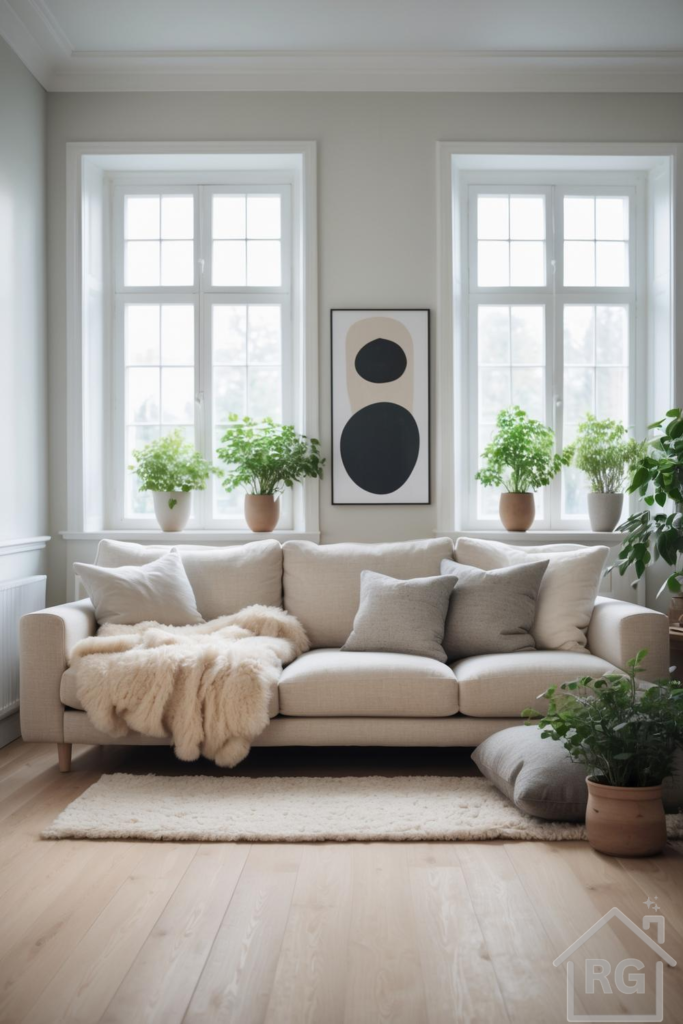
Designing Your Peaceful Scandi Retreat
Imagine a living space where light dances freely, textures invite your touch, and a profound sense of calm fills every corner. This is the essence of Scandinavian design. More than just an aesthetic, it’s a lifestyle embracing simplicity, functionality, and a deep connection with nature. If you dream of transforming your living room into such a peaceful haven, this guide will illuminate the key elements and principles to help you achieve that sought-after Scandi charm.
The Core of Scandinavian Style: Light, Nature, and Simplicity
At its heart, Scandinavian design prioritizes creating bright, airy, and uncluttered environments that foster well-being. The living room inspiration you’ve seen beautifully exemplifies these core tenets:
- Abundant Natural Light: Large, unobstructed windows are a hallmark, flooding the room with daylight and creating an uplifting atmosphere. Notice how the window frames are simple and white, maximizing light.
- Neutral and Muted Color Palette: The foundation is built upon soft, calming hues like creamy whites, gentle light greys, warm beiges, and natural wood tones. These colors reflect light, enhancing spaciousness and serenity.
- Natural Materials: Wood (like light oak flooring), wool, linen, and ceramic are prominent, providing warmth and organic texture.
- Hygge and Comfort: The Danish concept of ‘hygge’ – a feeling of coziness and contentment – is key. Soft textiles like sheepskin throws, plush pillows, and textured rugs invite relaxation.
- Minimalism with Purpose: Every item serves a function or adds beauty without clutter. Furniture boasts clean lines, and decor is thoughtfully chosen.
- Bringing the Outdoors In: Generous use of potted green plants adds natural color, purifies air, and strengthens the nature connection vital to Scandi living.
Key Elements to Recreate the Scandinavian Look
The Foundation: Walls and Flooring
The backdrop of your Scandinavian living room is crucial. Walls painted in a soft, off-white or very light grey create a canvas that amplifies light. This pairs beautifully with light-toned wooden flooring (like oak or ash), adding warmth and natural texture. This continuity of light colors on walls and floors makes the room feel more expansive and airy.
Get the Look:
- Opt for paint colors like ‘Chantilly Lace,’ ‘Simply White,’ or a very pale ‘Agreeable Gray.’ These are popular choices for their soft, light-reflecting qualities.
- Choose light wood flooring – engineered wood, laminate, or vinyl planks in oak, maple, or birch finishes are excellent and durable choices.
- Consider a matte finish for both walls and floors to diffuse light softly, enhancing the serene atmosphere.
The Centerpiece: Sofa and Textiles
Your sofa should be inviting and comfortable, ideally upholstered in a durable, light-colored woven fabric like a linen blend in creamy beige or light grey. Adorn it with a mix of throw pillows in varying neutral shades (greys, creams) and subtle textures. The star textile is often a luxurious sheepskin throw, casually draped for irresistible softness and visual warmth. Anchor the seating area with a cream-colored, textured wool or natural fiber rug to define the space and add comfort.
Get the Look:
- Select a sofa with clean lines and neutral upholstery. Fabrics like linen, cotton blends, or even a light boucle work wonderfully.
- Layer throw pillows in complementary neutral shades. Mix textures – a chunky knit, smooth cotton, a subtle pattern – for depth.
- A sheepskin or high-quality faux fur throw is a must-have for that iconic cozy Scandi touch.
- Choose a rug in a natural material like wool or jute, in a light, solid color or with a very subtle geometric pattern.
Art and Accents: Minimalist Elegance
Artwork in a Scandinavian living room acts as a focal point yet remains understated. Consider a large, framed piece featuring abstract geometric shapes, nature motifs, or minimalist line art in a simple color palette (e.g., black and beige). This minimalist approach is key. Other accents should be sparse but intentional, like simple terracotta or light-toned ceramic pots for plants.
Get the Look:
- Choose abstract, nature-inspired, or typographic art with a simple color palette. Black and white photography also works well.
- Opt for thin, minimalist frames in black, white, or natural wood.
- Keep decorative objects to a minimum. Focus on items that are both beautiful and functional, or that hold personal meaning. Think ceramic vases, wooden bowls, or a few curated books.
The Greenery: A Breath of Fresh Air
Plants are indispensable in a Scandinavian-inspired room, truly bringing the outdoors in. Strategically place a variety of green plants on window sills, shelves, and the floor to add life, color, and a stronger connection to nature. The choice of simple, earthy pots (terracotta, matte ceramic) enhances their natural beauty.
Get the Look:
- Incorporate a mix of plants with different leaf shapes and sizes. Consider popular choices like snake plants, fiddle leaf figs, pothos, monsteras, or ferns.
- Group plants together in clusters of varying heights for greater visual impact.
- Choose simple pots in materials like terracotta, ceramic (matte white, grey, or beige), or concrete.
Mastering the Scandinavian Color Palette
The Scandinavian color scheme is deceptively simple yet powerfully effective. It’s a harmonious symphony of neutrals that creates a calm and inviting atmosphere:
- Dominant Creamy Whites & Light Beiges: Used for walls, larger furniture pieces (like the sofa), and rugs to create a bright, expansive feel. These are warm, inviting off-whites, not stark clinical whites.
- Soft Greys: Incorporated through textiles (throw pillows, blankets) and potentially as a subtle wall undertone. These are typically warm greys or greiges (grey-beiges) that add depth and sophistication.
- Warm Wood Tones: Light-colored woods like oak, ash, maple, or birch for flooring, furniture legs, and accents bring natural warmth and texture.
- Black or Charcoal Accents: Used sparingly in elements like picture frames, lighting fixtures, or patterns in textiles to provide grounding contrast and visual interest.
- Earthy Greens: Introduced through indoor plants, these vital, organic colors enliven the neutral scheme.
- Subtle Dusty Hues: Occasionally, muted tones like dusty pink, soft sage green, or pale blue can be used as subtle accents in accessories.
Key Tip: When working with a predominantly neutral palette, the secret to avoiding a flat or monotonous look is to vary shades and introduce a rich tapestry of textures. This adds depth, warmth, and visual interest.
The Crucial Role of Texture in Scandi Design
In a predominantly neutral Scandinavian space, texture isn’t just an afterthought – it plays a starring role! It’s essential for adding depth, visual interest, and that all-important ‘hygge’ (cozy) factor. Think about layering various textures:
- Smooth vs. Rough: Contrast the smoothness of painted walls with the tactile qualities of woven sofa fabric, a chunky knit throw, or a natural fiber rug.
- Plush and Soft: Incorporate elements like sheepskin (or faux fur) throws, velvet cushions, or soft wool blankets that invite touch.
- Natural Weaves: Linen, cotton, jute, and rattan add organic appeal and subtle textural variations.
- Matte Finishes: Matte surfaces on walls, furniture, and decor absorb light gently, contributing to the soft, serene atmosphere, unlike glossy finishes which can feel harsh.
- Subtle Patterns: While not strictly a texture, subtle patterns in textiles (like a herringbone weave or a simple geometric print) can also contribute to textural interest.
Don’t be afraid to mix and match these textures. Combine chunky knits with smooth cottons, faux fur with linen, and natural wood grains with sleek ceramics to create a rich, inviting, and sensorially engaging environment.
Quick Tips for Your Own Serene Scandinavian Living Room
- Declutter Ruthlessly: Scandinavian design thrives on minimalism. Embrace the “less is more” philosophy. Keep only what is essential, beautiful, or brings you genuine joy.
- Prioritize Natural Light: Maximize daylight by keeping window treatments minimal. Sheer curtains, light-filtering blinds, or bare windows (if privacy allows) are ideal.
- Invest in Quality Basics: Choose well-made, timeless furniture with clean lines. These foundational pieces will last and form the backbone of your Scandi style.
- Layer Lighting Thoughtfully: While natural light is key, supplement it with a mix of artificial lighting. Include ambient (ceiling lights, floor lamps), task (reading lamps), and accent lighting (spotlights on art). Opt for warm white bulbs.
- Embrace Imperfection (Wabi-Sabi): While the look is clean and uncluttered, it shouldn’t feel sterile. A casually draped throw, a stack of well-loved books, or slightly imperfect handmade pottery adds character and warmth.
- Personalize with Intention: Add elements that reflect your personality, but do so with restraint. A few well-chosen books, a cherished photograph in a simple frame, or a unique ceramic piece can make the space truly your own without adding clutter.
- Focus on Functionality: Ensure every piece in your room serves a purpose. Smart storage solutions are key to maintaining an uncluttered look.
Your Scandinavian Sanctuary Awaits
Creating a Scandinavian-inspired living room is about more than just following design trends. It’s about crafting a space that nurtures your well-being, offers a genuine respite from the everyday hustle, and connects you with the simple beauty of natural elements and mindful living. By focusing on abundant light, natural materials, a calming color palette, and comfortable, inviting textures, you can transform your living room into the serene sanctuary you’ve always dreamed of.
Start small, make intentional choices, and most importantly, enjoy the process of bringing this peaceful, functional, and timeless style into your home. Your calm, cozy retreat is within reach!
